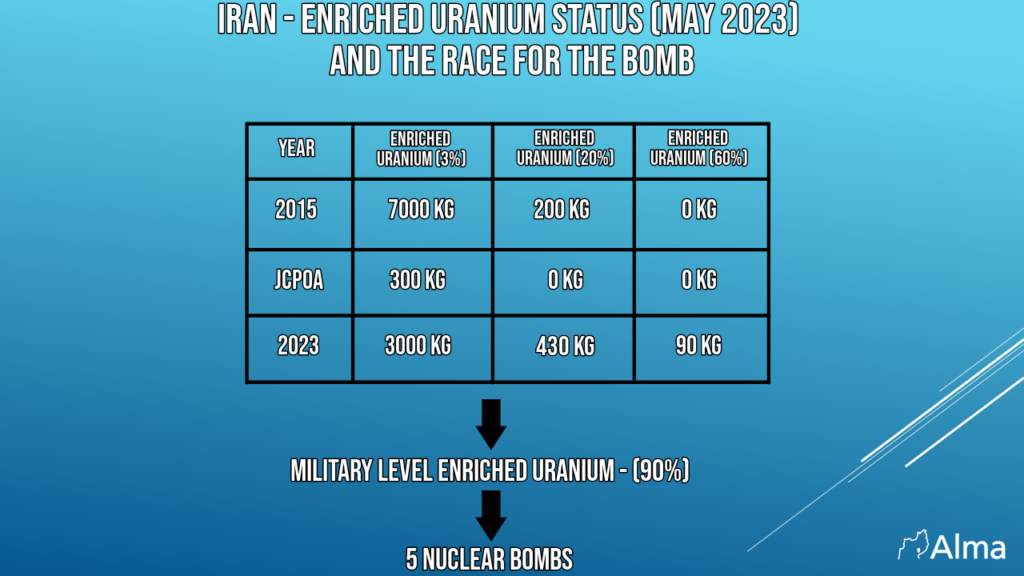Recent comments by the United States National Security Advisor, Jake Sullivan, appear to signal a new threat by Washington against Iran regarding its nuclear program.
This threat’s target audience is Iranian Supreme Leader Ayatollah Khamenei and his very small circle of decision-makers in the Iranian Supreme National Security Council.
The message was issued by U.S. National Security Advisor Jake Sullivan, during an address to the Washington Institute think tank on May 4.
“But what I will simply say is that on the deterrence side, working with our partners—including working very closely with Israel, including through that military exercise that I described before, but also through intensive sessions that I have personally participated in with everyone from the prime minister to the national security advisor to the minister of defense—we will continue to send a clear message about the costs and consequences of going too far, while at the same time continuing to seek the possibility of a diplomatically brokered outcome that puts Iran’s nuclear program back in the box,” Sullivan said.

It was the first occasion in a lengthy timeframe that an American official had discussed a military option in some detail, and with a more serious tone, in an effort to deter Iran from continuing to make progress on its nuclear program.
Sullivan’s reference to “working very closely with Israel,” and to a joint military exercise that occurred in January this year, involving American and Israeli forces simulating conflict with Iran, are unusual.
The Juniper Oak exercise, held between January 21 to 26, involved previously unseen levels of practiced military cooperation between forces subordinate to the U.S. Middle East military command, known as CENTCOM (Central Command), and the IDF.
The exercise was designed to practice operational cooperation and readiness against “regional threats.” Yet it seems hard to avoid the conclusion that Iran was the ultimate target audience.
Juniper Cobra involved around 6,500 American personnel on Israeli soil and on ships and aircraft arriving in the area, while the Israeli and American air forces practiced mid-air refueling for long-range strikes. The drill also involved transport helicopters, and the use of American B-52 bombing planes attacking simulated ground targets in southern Israel.
USAF Boeing KC-46 Pegasus refuelers topped up the fuel tanks of both IAF and USAF jets – allowing the IAF to practice receiving fuel from an aircraft that will act as its own future refueler, as it seeks to phase out its aging Re’em Boeing 707 refuelers.
Israeli Navy Sa’ar 5 missile ships practiced at-sea refueling with American tankers in the Mediterranean Sea.
The high profile war drill was reviewed by IDF Chief of Staff Lt. Gen. Herzi Halevi together with CENTCOM Commander Gen. Michael Kurilla on-board a U.S. aircraft carrier in the heart of the Mediterranean.
Altogether, it was a powerful projection of joint military power, and a signal of an ability, at least in theory, to join forces against the Iranian threat.
It is worth stressing that there is a big difference between practicing a joint strike, and reaching a stage in which governments in both Washington and Jerusalem actually order one.
Nevertheless, the exercise set the foundation for Sullivan’s May speech. It enabled him to issue deterrence statements with a little more seriousness than previous U.S. attempts at such deterrence against the Islamic Republic.
He described Juniper Oak as the “largest joint military exercise ever in the history of our two countries. There can be no doubt that we are walking the walk and not just talking the talk when we say that our commitment to Israel’s security is ironclad. That exercise was followed by one of the largest naval military exercises in the region’s history, with more than fifty international partners— including Israeli and Gulf partner navies—working side by side one another.”
During his speech, Sullivan reiterated the Biden administration’s position that “the best way to stop Iran from getting a nuclear weapon is an effective agreement that stops them from getting a nuclear weapon.”
He also heavily criticized the decision by the previous Trump administration to pull out of the Iran nuclear deal, known as the 2015 Joint Comprehensive Plan of Action (JCPOA) “without anything to replace it or any strategy to deal with it other than the imposition of sanctions.”
But most importantly, he acknowledged that Iran is back to enriching uranium at alarming levels, and that its nuclear program poses a major threat to global nonproliferation goals, as well as to regional security.
“At the end of the day, that’s the fundamental test: Iran cannot have a nuclear weapon. They do not today, and they cannot have one,” pledged Sullivan.
Wherever one stands on the JCPOA and its termination by the Trump administration, Iran’s current nuclear progress represents a blinking red light.
Whereas on the eve of the JCPOA, in the summer of 2015, Iran had 7,000 kilograms of low-enriched uranium, the JCPOA brought that figure down to 300 kilograms, and now, in 2023, Iran has more than 3,000 kilograms of low-enriched uranium, according to its own statements.
The real problem though is Iran’s growing stockpile of 20 and 60 percent uranium, since going from 3 percent to 20 percent enrichment levels is the toughest part of the enrichment cycle, whereas enriching further, to the 90 percent military-grade level, is far easier.
Iran had 200 kilograms of 20 percent enriched uranium in 2015, which then dropped to 0 after the JCPOA was implemented, and now has over 430 kilograms of this material, according to estimates by the United Nations International Atomic Energy Agency (IAEA). Iran had zero kilograms of uranium enriched to the 60 percent level in 2015, and now has around 90 kilograms of this, according to the IAEA.
All in all, Iran has enough uranium which, if enriched to 90 percent level , would suffice for five nuclear bombs.

While Israeli estimates still place Iran as being two years away from being able to actually build a warhead and place it on a missile, it is worth noting that in March this year, the U.S. Chairman of the Joint Chiefs of Staff, Mark Milley, warned that Iran could assemble complete nuclear bombs within several months – meaning that the American intelligence assessment is apparently more severe than the Israeli one on this matter.
In February, inspectors from the IAEA found uranium particles enriched to almost 85% at its Fordow enrichment agency, which is dug into a mountain.
For these reasons, the IDF has prioritized over the past year-and-a-half the goal of being ready to independently strike at Iran’s nuclear program, if called upon to do so.
The year 2022 marked a change in IAF priorities, when long-range strike capabilities involving detailed planning of aircraft usage, refueling, intelligence, and, of course, munitions, taking center stage, receiving billions of shekels in extra funding.
The former IDF Chief of Staff, Lt. Gen. Aviv Kochavi, confirmed in April 2022 that the Israeli military has fast-tracked its readiness program for Iran and that significant funds had been allocated to this effort.
Last year also saw large-scale independent IDF war drills simulating strikes on Iranian nuclear sites. This included the June 2022 Chariots of Fire exercise, which saw the IAF send large numbers of jets over the Mediterranean to simulate what it described as “long-range flight, aerial refueling and striking distant targets.”
As such, Iran is being confronted with two scenarios: One of a joint U.S – Israeli strike, and a solo Israeli strike. A third scenario of a solo American strike is theoretically possible but seems less likely.
The effect that such messages of deterrence are having on Ayatollah Khamenei and his inner circle is currently a mystery. The answer will be known soon enough when Iran’s nuclear progress either slows down or continues to steam ahead.





